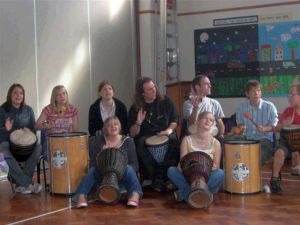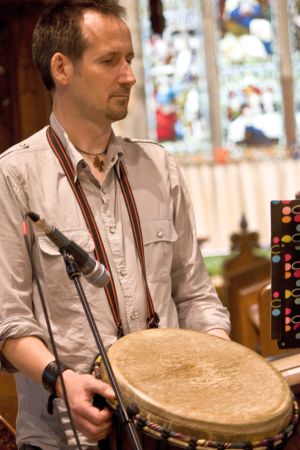The parish church of Truro, St Paul's, closed in November 2007 but the parish of St Paul continues to exist and worship is now based at Archbishop Benson CofE School. Parish priest, Father Christopher, describes how it is also home to… Holy Commotion!
On alternate Wednesdays during term time, we get together in the school hall – a licensed place of worship – for a short, informal act of worship with songs, a prayer, a reading and lots of fun. Everyone is welcome and we always tells people that if they don't fancy formal Sunday church but want to explore the Christian faith in a familiar and 'safe' environment, Holy Commotion! could be just the thing.
Emphasis is on informality and the involvement of children. As a result we have a regular kids club with activities designed specifically for them. For those wanting to explore their own spirituality or beliefs, or specific aspects of the Christian faith, we run an Emmaus course.
 Sometimes we have theme evenings at Holy Commotion when we get involved in other activities as part of our act of worship. Truro Methodist Church's Speaking in Drums group has visited us a couple of times.
Sometimes we have theme evenings at Holy Commotion when we get involved in other activities as part of our act of worship. Truro Methodist Church's Speaking in Drums group has visited us a couple of times.
As well as our regular Wednesday evening gatherings we also have social events for adults and/or children. It has come a long way since it first got off the ground a few years ago. I arrived here in 2003 and noticed that Christingle services always brought in so many people who would never otherwise come to one of our services. In 2006 the church was absolutely heaving with people; it was so packed we were putting visitors in the choir stalls and there was still standing room only at the back.
Afterwards I thought, 'This is incredible, where do all these people come from and where do they all go? Why are they happy to come to Christmas services but not at any other time?'
The answer, of course, was because they knew nothing 'strange' was going to happen. Even allowing for the fact that St Paul's is fairly strong Anglo Catholic – and people may not be familiar with that tradition – there was obviously a very different 'feel' about those Christingle services. People felt comfortable in coming to them.
In digging a little deeper about the whys and wherefores of it all we came to some serious conclusions about things we tend to take for granted in church circles:
- The day: Sundays are not good days to get to a service for many people;
- The place: Church buildings can be quite intimidating;
- The time: 10am is useless if you're taking your children to play football or some other sport; or arranging to transport them from one place to another if they're going to see a parent who no longer lives in the same home as they do;
- The formality of it all: Radical reassessment was needed because this thing called 'church' does not attract people in the same way these days. I have found that people of all ages, and whatever family or age bracket they happen to be in, are not averse to religion and spirituality but they don't like the way it is contextualised in institutional church.
 So we decided to launch Holy Commotion! in the school hall. We now have a very committed bunch of people and the way we break it down generally is that I do the 'bits' that requires someone with a dog collar and they do the 'commotion'. It's very informal and, to my mind, combines the best of both worlds to establish some kind of early church model.
So we decided to launch Holy Commotion! in the school hall. We now have a very committed bunch of people and the way we break it down generally is that I do the 'bits' that requires someone with a dog collar and they do the 'commotion'. It's very informal and, to my mind, combines the best of both worlds to establish some kind of early church model.
There was quite a milestone recently when we had our first ever baptism which means that people are now seeing that school hall as a holy, sacred place. They may not necessarily see themselves as Christians but they are interested in finding out about that thing called religion.
We worship, we pray, we sing, I talk to the children but the 'shape' of it is never quite the same! We also have a Eucharist from time to time. Holy Commotion! is all delivered on PowerPoint so people don't get mounds of books given to them; there is nothing scary about it. I find that if we take the scariness away, people really do open up.
We have children up to the age of 14 but don't seem to attract the older teenagers. In saying that, it has been successful beyond my wildest dreams in drawing people into the Christian family.
One of its wider effects can be seen in the number of baptisms having increased phenomenally across the benefice – most of whom are people who have come through Holy Commotion! and then fed back into other churches. It has also had an impact on my other congregations, we have introduced a fourth Sunday family service because the 9am Mass attracted one kind of clientele but it wasn't right for people with families. Now, after the Mass, the 9am crowd sit down for breakfast with the congregation arriving for the 10.30am service.
There have been some rumbles of 'It's all very nice but when are they going to come to proper church?' Well, Holy Commotion! is church and the fact is that these people simply will not come to what many think of as a church service. If they didn't go to Holy Commotion! they wouldn't go to church anywhere else – Wednesday has become the new Sunday for us.
I'm a high churchman and I was very much stepping out of my comfort zone when we first started – now I find it all hugely encouraging. The wonderful thing is that the people who come are here because they want to be here, not because they feel they should be here for whatever reason. Perhaps more importantly they tend not to come with any baggage, politics or prejudices associated with church life.
 Holy Commotion! is quite intensive in terms of energy and resources – and of course I have the life of the wider parish to look after as well but thankfully, because this is 21st century, I can communicate with the Holy Commotion! people extensively via email, text or Facebook.
Holy Commotion! is quite intensive in terms of energy and resources – and of course I have the life of the wider parish to look after as well but thankfully, because this is 21st century, I can communicate with the Holy Commotion! people extensively via email, text or Facebook.
There's no doubt that we really need to be doing this, we need to be doing both fresh expression of church and traditional church. It's the only way forward. When we started I was quite keen that whatever was to be presented had to have some kind of liturgical structure. That wasn't so much based on a deep theological reasoning, more that it was a complete experiment so I just stuck to what I knew and put together a service that was sort of familiar in structure. This included a welcome, gathering prayer, hymn or song and a reading from Scripture – I wanted it to be recognisable as church rather than just a social gathering.
People didn't find it off-putting. Instead they took to it all immediately because we forget how unusual it all is – they have not heard the Bible read so it's great to see their reaction to something like the Parable of the Good Samaritan. Also to have teaching is unusual because they don't know about Jesus. To me, that's what it's all about, a fulfilling life with a spiritual dimension. On the whole they are truly intrigued by it all because they see it as something incredibly relevant to today.
It could have such a different story on the first evening… we got to about 6.25pm and there were only three of us there. I was just about to say, 'Oh well it was worth a try but that's that' and then suddenly everyone came in through the door and there were about 36 people in the room. Our age range is from newborn to a lady in her 80s, the number fluctuates – for our harvest social there were more than 70 but I would say we have a core of 50.
Perhaps a testing time next year will be when I take a six-week sabbatical in March. I've tried to do my very best to get the message across that Holy Commotion! isn't me, it's them. My own personal resources are limited and one of the struggles is to try and think of new things to do, coming up with the ideas is tricky.
We need to resource it with people from either Holy Commotion! itself or other local churches. There are sufficient numbers of them to do that and the shape and form of it can continue in my absence because they now have a template to work from but they can develop it in different ways.



 Tanworth-in-Arden is a small rural parish between Birmingham and Redditch. Paul Cudby, vicar of St Mary Magdalene church, explains what they are doing to reach those who don't 'do' church.
Tanworth-in-Arden is a small rural parish between Birmingham and Redditch. Paul Cudby, vicar of St Mary Magdalene church, explains what they are doing to reach those who don't 'do' church.

 We're also in the process of developing a contemplative Eucharist under our 'Soul-Space' banner (a name derived from Greenbelt and an explorers group we run) for those attending our youth group. Five or six had decided they wanted to be confirmed but for most of them, Sundays are not a good time. I said I would be very happy to have a youth group communion service in the vicarage for them once or twice a term – very quiet, very reflective, lots of candles and incense. At this point I have given them a reflective outline to consider what they would like to do with it. They are excited at the prospect and so am I.
We're also in the process of developing a contemplative Eucharist under our 'Soul-Space' banner (a name derived from Greenbelt and an explorers group we run) for those attending our youth group. Five or six had decided they wanted to be confirmed but for most of them, Sundays are not a good time. I said I would be very happy to have a youth group communion service in the vicarage for them once or twice a term – very quiet, very reflective, lots of candles and incense. At this point I have given them a reflective outline to consider what they would like to do with it. They are excited at the prospect and so am I.